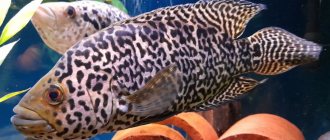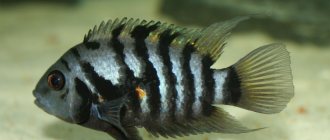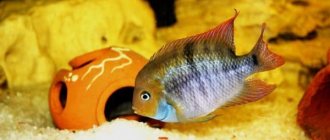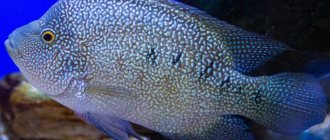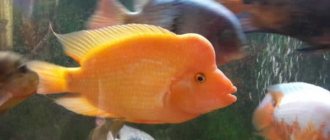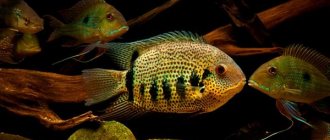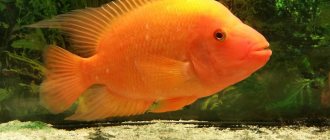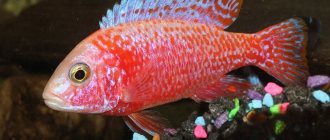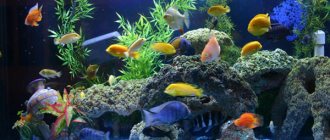Cichlasoma festae (lat. Cichlasoma festae) or orange cichlasoma is a fish that is not suitable for every aquarist. But, this is one of the best fish for those who want an extremely smart, extremely large, extremely colorful and incredibly aggressive fish.
Everything becomes extraordinary when we talk about cichlid fest. Smart? Yes. She may not be as smart as pets, but the orange one always wants to know where you are, what you are doing and when you will feed her.
Large? Even some! This is one of the largest cichlids, males reaching 50 cm and females 30 cm.
Bright? The fest has some of the most vibrant colors among cichlids, at least as far as yellow and red are concerned.
Aggressive? It really seems like these are not fish, but fighting dogs. And surprisingly, the female is more aggressive than the male. When she fully grows up, she will be the owner of the aquarium, no one else.
And yet, watching a pair of festa cichlases in an aquarium is a pleasure. They are large, bright, speak to each other, expressing themselves not in words, but in behavior, position and body color.
Description
This is a very large cichlid, in nature reaching a size of up to 50 cm in length. In an aquarium it is usually smaller, males up to 35 cm, females 20 cm.
The lifespan of Cichlazoma festa is up to 10 years, and with good care, even more.
Before maturity it is a rather inconspicuous fish, but then it becomes colored. What made it a popular fish among aquarists is its color, which is especially bright during spawning. Cichlazoma festa has a yellow-orange body, with wide dark stripes running along it.
The head, abdomen, upper back and caudal fin are red. There are also bluish-green sparkles running along the body. It is characteristic that sexually mature males are much paler in color than females, and they have no stripes, but a uniform yellow body with dark specks and bluish sparkles.
Area
In nature, Cichlazoma Festa is found in reservoirs located on the western slope of South America, from the Rio Esmeraldas River (Ecuador) to the Rio Tumbes River basin (Peru).
Cichlazoma Festa got its name in honor of Enrico Festa, who became the discoverer of this species. Orange cichlasoma is another name for fish, obtained due to the predominant color, which becomes especially bright during the spawning period. This species first became known to aquarium fish lovers around 1977.
Feeding
In nature, the orange cichlasoma preys on insects, invertebrates, and small fish. In an aquarium, it is best to make high-quality food for large cichlids as the basis of nutrition, and additionally provide animal food.
Such food can be: bloodworms, tubifex, earthworms, crickets, brine shrimp, gammarus, fish fillets, shrimp meat, tadpoles and frogs. You can also feed live crustaceans and fish, such as guppies, to stimulate the natural hunting process.
But, remember that by using such food you risk introducing infection into the aquarium, and it is important to feed only quarantined fish.
It is important to know that feeding mammalian meat, so popular in past years, is now considered harmful. Such meat contains a large amount of proteins and fats, which the gastrointestinal tract of fish digests poorly.
As a result, the fish becomes fat and the functioning of internal organs is disrupted. You can give such food, but not often, about once a week.
Festa cichlase diet
The basis of the diet of Festa cichlases in nature are small fish, all kinds of aquatic insects and invertebrates. They do not refuse plant foods, as evidenced by the contents of the stomachs of wild-caught specimens. Fest's cichlazomas are very voracious and consume almost all types of commensurate food, such as large bloodworms, minced meat and fish, shrimp meat, various frozen foods, dry food in the form of granules, etc. If possible, you can add insect larvae to their diet and earthworms. Plant foods are also important, namely: dandelion leaves, cabbage or lettuce, scalded with boiling water.
Keeping in an aquarium
As is the case with other large cichlids, the success in keeping Cichlizoma festa is to create conditions reminiscent of natural ones.
And when we are talking about very large fish, and also aggressive ones, it is also important to provide a lot of space for living, which reduces aggressiveness and allows you to grow large, healthy fish. To keep a pair of festa cichlases, you need an aquarium of 450 liters, or better yet much more, especially if you want to keep them with other fish.
The information found on the Internet about smaller volumes is incorrect, yes, they will live there, but it’s like a killer whale in a pool. Precisely because it is quite difficult to find bright and large fish on sale here.
It is better to use sand, a mixture of sand and gravel, or fine gravel as soil. Large driftwood, stones, and potted plants can be used as decoration.
It will be difficult for plants in such an aquarium; festas like to dig into the soil and rearrange everything at their discretion. So it is easier to use plastic plants. To keep the water fresh, you need to regularly change the water, siphon the bottom and use a powerful external filter.
This way you will reduce the amount of ammonia and nitrates in the water, since the festa produces a lot of waste and likes to rummage in the soil and dig up everything.
As for water parameters, this is an undemanding fish; it can live under very different parameters. But the ideal would be: temperature 25 -29°C, pH: 6.0 to 8.0, hardness 4 to 18°dH.
Since the fish is very aggressive, you can reduce aggression as follows:
- - provide plenty of hiding places and caves so that orange cichlids and other aggressive species like the Managuan cichlid can find shelter in case of danger
- - keep cichlizoma festa only with large fish that can stand up for themselves. Ideally, they should differ in appearance, behavior and feeding method. For example, we can cite the black pacu, a fish that is not a direct opponent for Cichlazoma festa
- - create a large amount of free space for swimming. Too cramped aquariums without space provoke aggression in all cichlids
- - keep the aquarium slightly overcrowded. A large number of different fish, as a rule, distracts the fest cichlases from any one victim. It is important to note that overcrowding should be small and only if the aquarium is equipped with a powerful external filter
- - and lastly, it is still better to keep festa cichlases separately, because sooner or later they will begin to spawn, which means that despite all your efforts, they will beat and chase their neighbors
Habitat
Comes from South America from the territory of modern Ecuador and northern Peru.
It is found in various biotopes, but as a rule, these are rivers flowing into the Pacific Ocean and their tributaries. This species was introduced to Southeast Asia, where it successfully took root, posing serious competition to local species. Brief information:
- Aquarium volume - from 300 liters.
- Temperature - 25–29°C
- pH value – 6.0–8.0
- Water hardness - soft to medium hard (5–18 dGH)
- Substrate type - sand
- Lighting - dim
- Brackish water - no
- Water movement - weak to moderate
- The size of the fish is 12–20 cm.
- Food - meat food
- Temperament - aggressive
- Keeping alone or in a mature male/female pair
Compatibility
A very aggressive fish, perhaps one of the most aggressive large cichlids. It is possible to keep them in spacious aquariums with the same large and pugnacious species.
For example, with Flower Horn, Cichlazoma Managuan, Astronotus, Eight-banded Cichlazoma. Or with dissimilar species: ocellated knife, plecostomus, pterygoplichthus, arowana. Unfortunately, it is impossible to predict the outcome in advance, since much depends on the nature of the fish.
For some aquarists they live quite peacefully, for others it ends in grass and the death of the fish.
But, nevertheless, aquarists who kept festa cichlases come to the conclusion that they need to be kept separately.
Appearance
False discus are distinguished by a rounded, somewhat laterally compressed body, which allows them to skillfully maneuver when moving and deftly go around various obstacles.
They have elongated plumage, with anal and dorsal fins originating from the head itself and extending across the entire body.
The color of the fish is formed depending on the parental color and which gene predominates. If the dominant gene is dominant, then the scales will be greenish, if the recessive gene is more likely to be yellow.
There are albino severums who do not have a predominant color gene. These cichlids have a very interesting iris - large and with a pronounced red tint.
Breeding
Cichlazoma festa begins to breed when it reaches a size of 15 cm, this is about a year of its life. Eggs are laid both on driftwood and on flat stones. It is better to use stones with a rough structure (so that the eggs stick well) and dark in color (the parents have seen the eggs).
Interestingly, fish can behave differently. Sometimes they dig a nest into which they transfer the eggs after they hatch, and sometimes they transfer them to some kind of shelter. As a rule, this is a small hill containing 100-150 eggs.
The eggs are quite small, considering the size of the parents, and hatch 3-4 days after spawning, it all depends on the water temperature. All this time, the female fans the eggs with her fins, and the male guards her and the territory.
After the eggs hatch, the female transfers them to a pre-selected shelter. The fry begins to swim on days 5-8, again it all depends on the water temperature. You can feed the fry egg yolk and Artemia nauplii.
Cichlazoma Festa or Orange cichlazoma (Nandopsis festae)
Cichlazoma Festa or Orange cichlazoma (Nandopsis festae) is quite large in size relative to a home aquarium. In the natural environment it can reach up to 27 cm in length. The fish was discovered by Enrico Festa and named after him.
Georges Boulenger presented a description of this species in 1899, and hobbyists began breeding it in their aquariums in the seventies of the last century. Until now, taxonomists have not yet decided on a category, so they conditionally classified it as a cichlizoma. Representatives of the species have a slightly elongated, flat body, a fairly massive head with huge eyes.
It should be noted the beautiful color of the fish, which significantly distinguishes them from others. Males have a golden-yellow body with bluish sparkles. Females are even more beautiful - the body is bright orange, with sparkles and black stripes. Both sexes have darkened spots located in the upper part of the tail, unpaired fins, orange in color, in the male - dark red. Cichlazoma Festa is a typical predator and is given away by its huge mouth with red-orange lips. When spawning continues, the color of the fish becomes more noticeable and expressive, which can be immediately noticed.
Nandopsis festae was awarded the commercial name "Red Terror" because it has aggressive tendencies, the same situation with the turquoise acara, called "Green Terror". Both varieties come from the same region of South America - the northwest.
When the first batches of fish were sent for import, in more frequent cases they were replaced by less attractive and equally aggressive variants called Cichlazoma urophthalmus. When the fish are small, they have a strong similarity to each other and the second one was soon awarded the name “false Festa”.
The distribution area of this species is part of the Andes slope, on the South American continent, it extends from the Rio Esmeraldas basin to the Rio Tumbes. The most favorable place for normal life of the species is shallow water with soft soil. Here the water is quite warm, its temperature is 24-28°C, hardness 2 - 10 dGH, however, the presence of an alkaline reaction (pH 7.5-8.5) is different. Typically, Cichlazoma Festa or Orange Cichlazoma is more active at night, then it begins to hunt for a variety of small animals, and when it is light, it hides in a pre-made hole.
Features of keeping fish in an aquarium
In order for fish of this variety to live comfortably, it is recommended to purchase a home tank with a volume of no less than 400 liters, so that there are areas for unobstructed swimming and special shelters for the female. They are extremely capricious, the properties of water are important to them, therefore the most suitable indicators have been established: hardness 8 - 20 dGH, pH 6.5-8.5, temperature 22-26 ° C. Every week you need to filter the water and change it approximately 30-40%. This is the only way to provide good conditions for capricious fish.
Cichlazoma Festa have a pronounced tendency to restore order in their own home, aquarium, and only the way they want, to their liking. This can be seen in their behavior: they constantly dig the soil, move stones, and pull out vegetation they don’t need.
To provide them with good, high-quality soil, you should pay attention to crushed pebbles or granite chips. The bottom should be filled with large stones and driftwood, with the help of which you can subsequently divide the entire area into zones. Also, this type of decoration, if the need arises, can become a reliable shelter where fish will hide, and flat stones in the future will become a convenient substrate for laying eggs.
You should not place other types of fish with them, because of their excessive aggressiveness, so that they do not injure each other. In the American species of cichlids, aggression manifests itself depending on the volume of the tank in which they live. If at first a relatively small container is enough for young species, then when they start to grow, they will definitely need a larger volume.
In an aquarium, fish become much larger in size than in the natural environment; for this reason, in a tank of small size, even a fairly friendly and peace-loving couple can begin to conflict.
In principle, most aquarists will rarely encounter circumstances in which a male kills a female. Many fanciers know: after the fry are removed, you need to carefully monitor the female. During this period, the degree of aggressiveness of the male towards her increases and trouble may occur.
If it is not possible to move the couple to a larger and more spacious aquarium, you can try this option: install a transparent partition with holes large enough for a small female to pass through. If a conflict breaks out, she will be able to escape unhindered. This method will help to keep a couple in tanks of 200-300 liters, and this is an excellent opportunity to exist and reproduce normally.
You should not place live vegetation in the aquarium, because the Orange Cichlazoma will simply destroy it. If it is difficult to refuse it, then you can use the following method: plant the vegetation in separate containers, bury it in the soil, and strengthen it with large stones. To achieve the desired landscaping, you need to select fast-growing varieties or vegetation that has a strong root system and tough foliage. Elodea, Vallisneria, as well as large varieties of Echinodorus and Cryptocoryne are considered good options.
Fish need lighting, but its duration is more important; it must be present for about ten hours a day. Other properties must be provided in accordance with the requirements of the vegetation. In most cases, fluorescent lamps with a power of 0.3−0.5 W/l. can provide lighting sufficient for the normal functioning of fish.
Diet
The main food for cichlases are small fish, various insects near water, and invertebrates. They also consume plant foods, which was noticed during the study of specimens caught in the natural environment. Fish are considered to be quite voracious, they love almost all types of food, they love to feast on large bloodworms, fish and minced meat, shrimp meat, and dry food. If possible, it is worth adding insect larvae and worms to the general diet. Food of plant origin, for example, dandelion leaves, lettuce, cabbage, is of great importance.
Sexual dimorphism of fish
It is enough to simply recognize the male and female of this species. Males are larger and have a fatty growth on their forehead. In addition, females are much more colorful and attractive than males. When the spawning period continues, the fish develop an anal tubercle - slightly pointed in the male, pyramid-shaped in the female. The male takes on a greenish tint.
Reproduction
When the fish reach fourteen to sixteen months of age and a body length of 15 cm, they are mature enough to reproduce. Because pairs form at a fairly early age, it is recommended to buy fish in a small group, including six to ten individuals. To create pairs of already matured fish, you need to divide the aquarium into two zones using glass or mesh. The barrier can be removed only when it becomes clear that the male and female are suitable for each other. But this method is not always successful and does not always lead to the desired result.
It is necessary to observe how the relationship between the fish that produce fry develops even after the partition is removed.
Often the female tries to test the male’s strength; a kind of fight occurs, during which she evaluates his strength. If the fight ends in the victory of the female, then one of the partners must be changed. An important point: in a formed pair the male must be stronger, only then will there be harmony between the fish, which in the future will entail the generation of offspring.
The main motive for spawning is an increase in water temperature to the level of 26−28 ° C, a decrease in water hardness to 10 dGH. The pH level should be maintained to 7 units and the water should be changed twice a week. In most cases, the female lays eggs on a stone, if it is available in a reservoir, previously cleaned by the male. Eggs in a clutch can vary in number from 100 pieces to 1000 pieces, and this directly depends on the conditions in which the fish are located, nutrition, age, and size of the spawners. The incubation period can last approximately three to four days and is affected by water temperature. The parents move the larvae into a previously prepared hole.
Cichlazoma Festa or Orange cichlazoma carefully guard their own clutch, driving away other fish from the territory; moreover, they can fearlessly attack a net, even the hand of an aquarist trying to set up an aquarium.
Producers surprisingly selflessly fight for the safety of their own offspring, in addition, they unanimously participate in their feeding. This procedure can be carried out in two ways: either the parent grinds up food for them, spitting out the fry into the flock, or adults secrete a special skin secretion, which plays the role of “milk” for feeding the offspring.
There is a problem that can arise in the process of breeding cichlazoma - this is the desire of couples to keep their offspring in a shelter for a long time, not to allow the fry to swim freely in the reservoir, looking for food. At this moment you should intervene so as not to lose the brood. A rather interesting sight is the procedure of the parents walking the fry; they try to signal about the approaching danger and force them to hide.
If the couple is experienced and has spawned several times, then you can leave the fry with them for fourteen days. But the best option would be to move them to another container. In a nursery aquarium, movement is usually done using a hose, and the water should have properties similar to those in a spawning tank. The fry are usually gray with stripes and turn orange when they mature.
The initial food for the fry is Artemia nauplii; as they grow older, they are divided by size and after that they are switched to standard large food. When the age of two months is reached, the water in the aquarium may have indicators that should be present when adults are in it.
Generally speaking, breeding cichlazomas is not easy. As mentioned above, there are difficulties in selecting a suitable pair and the availability of high quality water is assumed. In addition, there is a high probability of the fry leaving; out of several hundred eggs, only a few dozen fry can survive - this would be the best option.
Young fish are much more peaceful compared to mature fish. If in a reservoir they coexist with juveniles of other cichlids, they most often experience oppression. If they have a good appetite, the fry grow slowly and only after three years can they reach large sizes. Further care for the fish does not involve any special problems, you just need to provide an aquarium of the proper size.
The aggressiveness of Cichlazoma Festa is fully compensated by many advantages. Outwardly, they are so beautiful that they are no worse than colorful coral fish, and their behavior during breeding and caring for them is an impressive sight!
If you notice an interesting, large, brightly colored fish with unusual behavior, you can be sure that it is an Orange Cichlasoma. If you want to start breeding it, you should remember: for comfortable and successful keeping of a pair, you need an aquarium with a capacity of at least 400 liters. This is not only because of the size of the fish, but also because it requires a lot of space.
We should not forget about providing high quality water, periodically replacing it or effective filtration. But the main thing is to show maximum patience, treat with understanding and leniency the complex nature of this species of fish.
